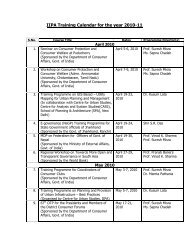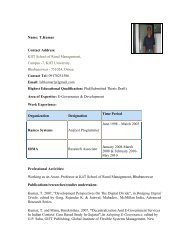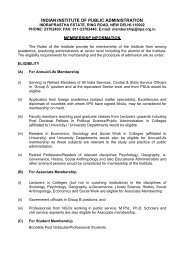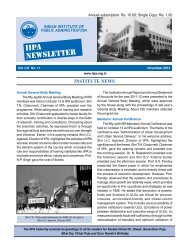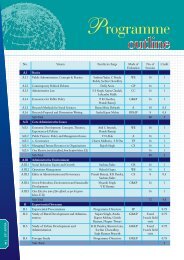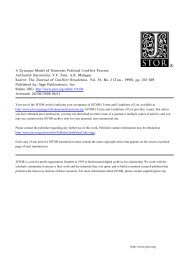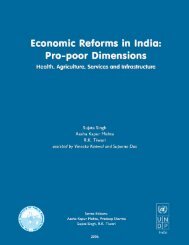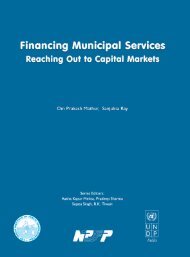<strong>Privatisation</strong> <strong>of</strong> <strong>Health</strong> <strong>Care</strong> <strong>in</strong> <strong>India</strong>2Globalisation and <strong>Health</strong> Services:An OverviewviewThe most significant and widespread global trend <strong>in</strong> healthcare over the past decade and more has been the <strong>in</strong>creas<strong>in</strong>gshare <strong>of</strong> the ‘for pr<strong>of</strong>it’ health care sector and itsmarketisation across societies. This transformation <strong>in</strong> thehealth care sector has paralleled the process <strong>of</strong> economicglobalisation and is <strong>in</strong>tr<strong>in</strong>sically l<strong>in</strong>ked to it.While private medical practice and the dispensation <strong>of</strong>medical care for a price have been known for a long time,the commercialisation, marketisation and corporatisation<strong>of</strong> health care are a phenomenon <strong>of</strong> the last quarter <strong>of</strong> the20 th century. Due to global recession, this process receiveda boost dur<strong>in</strong>g the late seventies and early eighties, envelop<strong>in</strong>gboth developed and develop<strong>in</strong>g countries, impos<strong>in</strong>gfiscal constra<strong>in</strong>ts on government budgets and encourag<strong>in</strong>gthem to cut back on public expenditure <strong>in</strong> the socialsectors. This <strong>in</strong>creased the space for the growth <strong>of</strong> theprivate sector <strong>in</strong> the provision<strong>in</strong>g <strong>of</strong> health care, whichwas accelerated dur<strong>in</strong>g the eighties and n<strong>in</strong>eties with the<strong>in</strong>creas<strong>in</strong>g role <strong>of</strong> the pharmaceutical and medical equipment<strong>in</strong>dustries’ <strong>in</strong> seek<strong>in</strong>g markets for their products.In this process <strong>of</strong> globalisation mult<strong>in</strong>ational corporationshave systematically targeted both <strong>in</strong>ternational agencies andnational governments for policy <strong>in</strong>fluence, def<strong>in</strong><strong>in</strong>g prioritiesfor disease control programmes, provision<strong>in</strong>g <strong>of</strong> healthcare and medical research at the national level. Typicallythese MNCs (mult<strong>in</strong>ational companies) have <strong>in</strong>fluencednational policies through multilateral agencies like the WorldBank, the World <strong>Health</strong> Organisation and the World TradeOrganisation, <strong>in</strong> key areas such as provision<strong>in</strong>g and research<strong>in</strong> health care. They have <strong>in</strong>fluenced development fund<strong>in</strong>g<strong>in</strong> the social sectors, secur<strong>in</strong>g focus for programmes witha higher curative content. They have encouraged the fund<strong>in</strong>g<strong>of</strong> curative and drug-based programmes rather thanfocus<strong>in</strong>g on public health and preventive programmes.Through the WTO, the policy framework for <strong>in</strong>tellectualproperty protection has been aimed at protect<strong>in</strong>g pharmaceuticalcompany bottom l<strong>in</strong>es and help<strong>in</strong>g them generatesuper pr<strong>of</strong>its. Such policy <strong>in</strong>terventionism has ensuredthe fund<strong>in</strong>g <strong>of</strong> specific programmes, the creation<strong>of</strong> a market for drugs and equipment and the free<strong>in</strong>g <strong>of</strong>state control on the market. Dur<strong>in</strong>g the n<strong>in</strong>eties, the WHO<strong>in</strong>creas<strong>in</strong>gly went <strong>in</strong> for partnerships with the <strong>in</strong>dustry,especially for the tropical disease research programmes.(Brundtland, 2000)The <strong>in</strong>creased <strong>in</strong>fluence <strong>of</strong> global drug mult<strong>in</strong>ationals <strong>in</strong>the n<strong>in</strong>eties has been facilitated by the recent trend towardsmergers and the <strong>in</strong>creased concentration <strong>of</strong> sell<strong>in</strong>gpower with<strong>in</strong> the pharmaceutical <strong>in</strong>dustry. As a result <strong>of</strong>these mergers, a few corporations account for the bulk<strong>of</strong> pharmaceutical sales <strong>in</strong> the world. Many <strong>of</strong> these companiesexport drugs, vacc<strong>in</strong>es and biological <strong>in</strong>strumentsto developed and develop<strong>in</strong>g countries. The majorpharmaceutical, equipment and <strong>in</strong>surance related MNCsare based <strong>in</strong> the United States. Dur<strong>in</strong>g the n<strong>in</strong>eties they expandedtheir markets across several develop<strong>in</strong>g and developedcountries. This process was also accompanied by the2
Globalisation and <strong>Health</strong> Services: An Overview<strong>in</strong>creased importance given to the growth <strong>of</strong> the ‘for-pr<strong>of</strong>it’health care sector.2.1. International Experience withMarketisation <strong>of</strong> <strong>Health</strong> <strong>Care</strong>The trend towards the commercialisation and marketisation<strong>of</strong> health care dur<strong>in</strong>g the last three decades cuts acrossboth developed and develop<strong>in</strong>g countries. While the UnitedStates has been a leader <strong>of</strong> the ‘market model’, the phenomenonis spread<strong>in</strong>g even to “socialist” societies. Marketforces have largely controlled f<strong>in</strong>anc<strong>in</strong>g, provision<strong>in</strong>g andresearch <strong>in</strong> the health care sector <strong>in</strong> the U.S. F<strong>in</strong>anc<strong>in</strong>g hasbeen largely managed through <strong>in</strong>surance companies, provision<strong>in</strong>gby large hospital corporations and research bypharmaceutical and medical equipment companies. Thegovernment’s role has been m<strong>in</strong>imal and <strong>in</strong>cludes provid<strong>in</strong>gpublic <strong>in</strong>surance to the elderly and poor, draw<strong>in</strong>g upregulatory guidel<strong>in</strong>es for the private sector and giv<strong>in</strong>g subsidiesfor private medical care (Brown, 1984). Themarketised model <strong>of</strong> American medical care came undersevere criticism dur<strong>in</strong>g the eighties. Criticism essentially focussedon the ris<strong>in</strong>g costs <strong>of</strong> medical care, excessive emphasison curative and high technology care, the dom<strong>in</strong>ance<strong>of</strong> medical technology and pharmaceutical <strong>in</strong>dustries<strong>in</strong> medical care. The critics further argued that thesetrends marg<strong>in</strong>alised sections <strong>of</strong> the middle and work<strong>in</strong>gclasses from access to health care. This was corroboratedby the <strong>in</strong>crease <strong>in</strong> both the un<strong>in</strong>sured and under-<strong>in</strong>suredpersons dur<strong>in</strong>g the eighties and the n<strong>in</strong>eties. The un<strong>in</strong>suredconsumers <strong>of</strong> health services were largely drawn from thework<strong>in</strong>g class and some sections <strong>of</strong> the middle class.(Carrasquillo et al, 1999) Given the high cost <strong>of</strong> medicalcare, the un<strong>in</strong>sured were effectively denied access to healthcare. However, efforts to <strong>in</strong>troduce universal public <strong>in</strong>suranceand other progressive reforms were resisted both bythe pharmaceutical companies and the ‘for pr<strong>of</strong>it’ healthcare providers.Despite the problems faced by the US health care system,most countries have been mov<strong>in</strong>g towards the Americanmodel <strong>of</strong> care where the private sector plays a dom<strong>in</strong>antrole. This undoubtedly is a consequence <strong>of</strong> globalisationand the <strong>in</strong>fluence <strong>of</strong> the U.S. experience on other countries,an <strong>in</strong>fluence which has been partly communicatedthrough the media and public perceptions <strong>of</strong> what is acceptableand partly imposed by multilateral lend<strong>in</strong>g agencieslike the World Bank. These agencies have strongly advocatedprivatisation measures <strong>in</strong> health care as part <strong>of</strong> thestructural adjustment programmes. This position was wellarticulated <strong>in</strong> the World Development Report 1998, thatwas entitled, ‘Invest<strong>in</strong>g <strong>in</strong> <strong>Health</strong>’ (Rao, 1999).Countries <strong>in</strong> Europe, Africa, Lat<strong>in</strong> America and Asia thathad built state-supported health services dur<strong>in</strong>g the sixtiesand seventies, have now encouraged privatisation both asa response to the fiscal crisis <strong>of</strong> the public sector and t<strong>of</strong>ulfil conditionalities l<strong>in</strong>ked to multilateral lend<strong>in</strong>gprogrammes ( Jimenez & Bossert, 1995). The erstwhileSoviet Union and several central and eastern Europeancountries have gone through a process <strong>of</strong> marketisationwith a subsequent weaken<strong>in</strong>g, and <strong>in</strong> some cases even dismantl<strong>in</strong>g,<strong>of</strong> state services. Similarly, Ch<strong>in</strong>a has also beenmarketis<strong>in</strong>g its health services and is encourag<strong>in</strong>g MNCsto enter the health care market. Studies show that <strong>in</strong>creas<strong>in</strong>gmarketisation <strong>of</strong> health care has pushed up the cost <strong>of</strong>medical care and has contributed to <strong>in</strong>creased <strong>in</strong>equality <strong>in</strong>access to services across regions and classes <strong>in</strong> Ch<strong>in</strong>a(Acharya et al, 2001).Similar trends are visible <strong>in</strong> the UK, several West Europeancountries and <strong>in</strong> East Asia. In the UK, several Americanhospitals and <strong>in</strong>surance companies entered the market dur<strong>in</strong>gthe eighties. Dur<strong>in</strong>g the same period, efforts were madeto restructure the National <strong>Health</strong> Service <strong>in</strong> order to reducegovernment spend<strong>in</strong>g. Several other countries <strong>in</strong> Africaand Asia have followed similar paths, with reduction <strong>in</strong>government spend<strong>in</strong>g on health care and an <strong>in</strong>creased pushfor privatisation. This has meant the shift<strong>in</strong>g <strong>of</strong> responsibilityto <strong>in</strong>dividual households to pay for health care (Price,1989). The consequences <strong>of</strong> marketisation have been welldocumented for Lat<strong>in</strong> America and Africa, as also for someAsian countries. These studies show that access to care hasbeen reduced for the poor, costs <strong>of</strong> drugs are high, and theprivate sector serves only those who can pay.3




